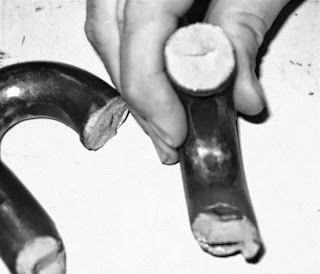by Don Cooper, District Manager, WiscoLift, Inc.
The worst part of our job is when we are involved with our customers’ response to a lifting accident. Our customer has purchased the proper hoist and below the hook devices. The weight load is within the working load limit of the lifting equipment. In many cases, the operator has had some level of safe lifting training. Effective training helps people to focus on prevention as the majority of lifting accidents are caused by operator error. We hope that by sharing these occurrences, focus may be increased to help prevent future accidents.
Accident Cases and Recommended
Preventive Measures
- Operator using battery magnet to lift 400 pound piece of steel. Operator did not recharge battery on the magnet. Kicked load with foot to test and then dropped 400 pounds on same foot causing multiple broken bones. -- Check the charge status of batteries before each use.
- Operator using permanent magnet dropped 500 pound box. Operator did not realize downrating of the magnet when using with a thin material. -- Always check the capacity chart of the magnet before use and pay particular attention to thickness, shape (flat/round surface), cleanliness, roughness, and length of steel.
- Crane sheet lifter collision with fork truck. Crane operator using personal cell phone while operating a crane. -- Duh! Cell phones should not be used while operating machinery!
- Operator snags pallet lifter on corner of pallet racking, drops four steel coils on legs. -- An operator should be constantly aware of his/her surroundings and potential obstructions. Operator should always be walking forward behind the load rather than backwards in front of load.
- Operator decides to decrease amount of touch up painting required by balancing 2000 pound load on tips of hooks. Operator suffered critical head, torso, and leg injuries.-- OSHA 1910.184(c)(6) states, “Slings shall be securely attached to their loads”.
- Back injury. Employee didn't want to use box vacuum lifter provided by company as he felt it was too slow. -- Ergonomic devices are designed to help prevent on-the-job back injuries.
- Operator snags hoist hook. As a result of operating the hoist and not watching hook, he lost his eye. -- The Operator should always focus on load and hook when operating.
- Pendant button sticks and operator panics rather than pushing power off button on pendant. Drops 8000 pound load almost resulting in fatality. -- Read the Pendant Control instructions included in the Owner’s Manual before using, and follow all OSHA and manufacturer inspection requirements.
- Employee twists chain on new chain sling to shorten. Chain failure results in 8000 pound load falling in aisle resulting in a near miss. – Only properly rated and approved hardware should be used with chain slings. Operator should always inspect before using.
- Crane operator on one side of conveyor lifted product to aisle on other side of conveyor. Due to the height and width of product, operator did not notice coworker in aisle. Coworker was pinned against building column resulting in fatality. -- OSHA 2236 states, “When using aisles and passageways to move materials mechanically, workers must allow sufficient clearance for aisles at loading docks, through doorways, wherever turns must be made, and in other parts of the workplace. Providing sufficient clearance for mechanically-moved materials will prevent workers from being pinned between the equipment and fixtures in the workplace, such as walls, racks, posts, or other machines. Sufficient clearance also will prevent the load from striking an obstruction and falling on an employee”.
We
cannot underestimate the need to implement continued safety training to raise
the awareness of all potential lifting accidents. All operators are always to
stay clear of suspended loads and follow safe lifting practices at all times.
Are
your employee’s using safe lifting practices? For information regarding
WiscoLift’s individualized Safe Lifting
training program, contact our Sales representative at 800-242-3477.


